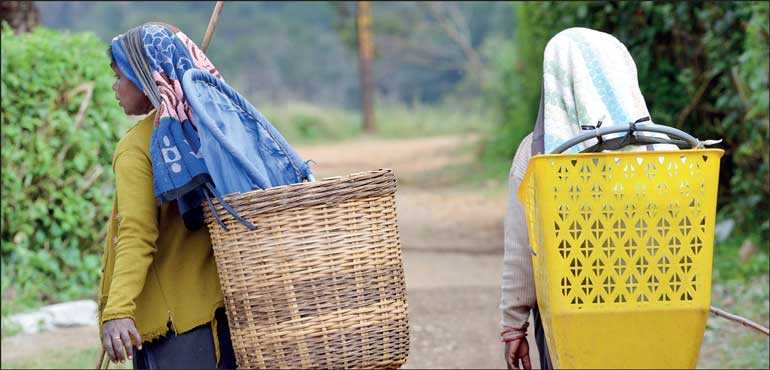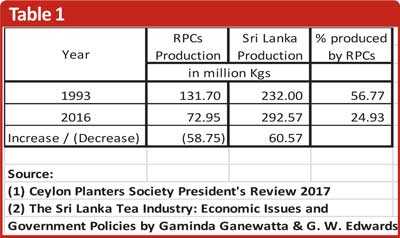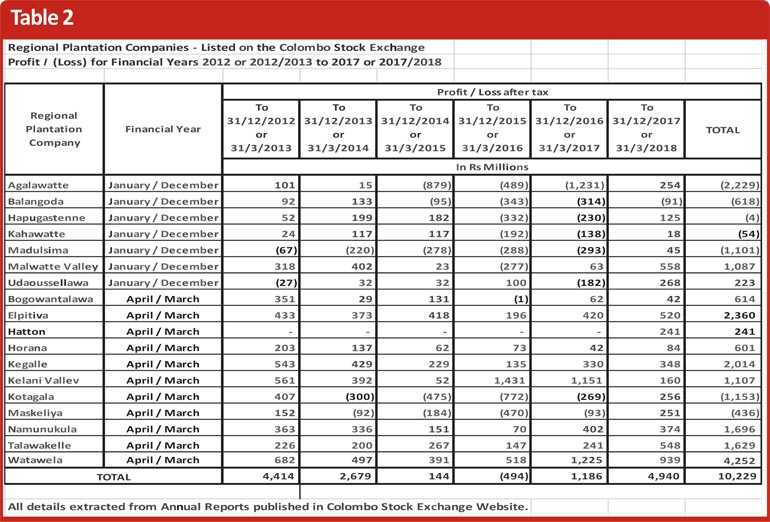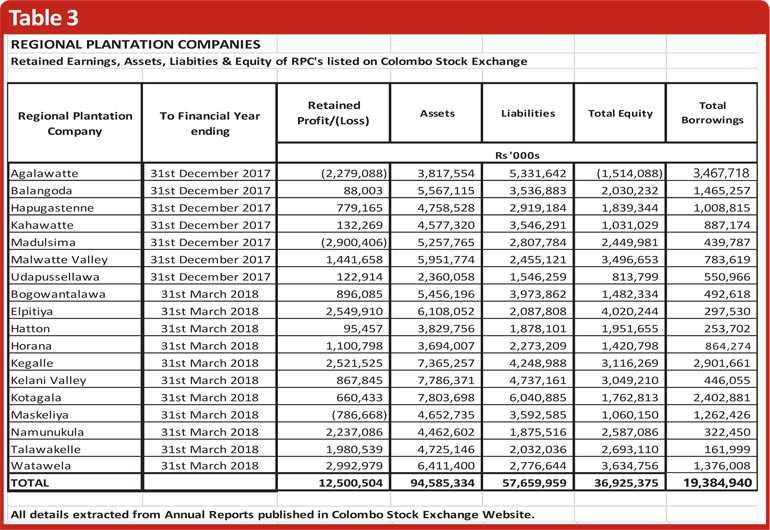Thursday Jan 01, 2026
Thursday Jan 01, 2026
Wednesday, 20 February 2019 00:00 - - {{hitsCtrl.values.hits}}

By Devaka Wickramasuriya
The response by the Planters’ Association of Ceylon (PA) to Minister Kiriella’s comments have been read with interest. Prior to commenting on the responses of the PA, purely to point out the inaccuracies and incorrect positions stated therein, the writer wishes to give readers the history of the PA.
History of the PA
The PA was established in 1854 and was a body created by the working planters for the working planters.Therefore, the main body of the PA, including its chairman, comprised working planters and was created to find solutions to the issues faced by the working planter. There was another branch of the PA which was the  ‘Agency Section of the PA,’ which was chaired by a senior director of an agency house and created to deal with any issues faced by the agency houses which managed plantations prior to nationalisation. With the nationalisation of estates in 1975, the PA went into abeyance and its only functions were the management of the Ceylon Planters’ Provident Society and the Estate Staff Provident Society. However, with the privatisation of the management on plantations in 1992, the “plantation arm” of the PA was revived by its then Secretary General, the legendary Sepala Ilangakoon.
‘Agency Section of the PA,’ which was chaired by a senior director of an agency house and created to deal with any issues faced by the agency houses which managed plantations prior to nationalisation. With the nationalisation of estates in 1975, the PA went into abeyance and its only functions were the management of the Ceylon Planters’ Provident Society and the Estate Staff Provident Society. However, with the privatisation of the management on plantations in 1992, the “plantation arm” of the PA was revived by its then Secretary General, the legendary Sepala Ilangakoon.
With this revival, the Constitution of the PA was amended permitting the “managing agents” of plantations to hold office in the main body of the PA as well as to control its affairs. This resulted in the working planter being unceremoniously evicted in conducting the affairs of the PA and thereby becoming a virtual non-entity in an association that was created for him. With the revival of the PA in 1992, the ‘agency section,’ in which the managing agents of plantations should have been members, was ironically not revived.
Therefore, with the representatives or employees of the majority shareholders of Regional Plantation Companies (RPCs) now holding office and controlling the affairs of the PA, they are not those who were intended to do so at the time the PA was created. In fact, the PA which was created to find solutions to the issues of the working planter, has now become the mouthpiece of the RPCs!
The sensible and just course of action would have been for the RPCs to use the “agency section” of the PA to resolve/address their grievances and to permit the main body of the PA to function under the working planters and for what it was created for in the first instance, i.e. to cater to the issues faced by the working planter. In the writer’s opinion, amending of the constitution of the PA, and thereby permitting the representatives or employees of the majority shareholders of RPCs to control the PA, was probably the only folly of the legendary Sepala Ilangakoon, who would obviously have never imagined what the consequences of his actions would ultimately be.
Referring to the responses of the PA to what Minister Kiriella is alleged to have said, the writer responds as follows;
Rs. 1,000 daily wage demand
The PA states that the RPCs pay their workers through what they earn as revenue and that the average sale price of tea at the Colombo Auctions would have to increase to Rs. 850per kilogram to enable them to meet the workers demand of a daily wage of Rs. 1,000.
Privatisation of plantations was considered necessary and done to ensure that “private sector management styles and dynamism”, which were prevalent prior to nationalisation of plantations, be re-introduced.However, despite the RPCs having every opportunity of doing so and undertaking “value addition” and or “direct marketing” of their produce, they did not do so and continued to depend on the archaic auction system.At a recent workshop, a leading tea exporter, who also holds the majority shareholding of an RPC, stated that the price he obtains for the tea he exports, after value addition, is around three times that what is paid for at the Colombo Auctions. This makes it obvious that it is the “middle man” who makes the biggest profit on the entire exercise.
The RPCs have been in existence for 26 years and had every opportunity of marketing at least a part of their produce either directly (by passing the archaic auction system) or after “value addition”, thereby obtaining enhanced prices which would have easily enabled them to meet the demanded wage increase or even more.
Therefore, the inability of the RPCs to pay the workers the daily wage of Rs. 1,000 requested for is for no reason other than their inability to increase revenue by adopting “private sector management styles and dynamism” in the marketing of their produce, which was expected of them when plantations were privatised.
Lowproductivity, high COP and cost of labour
The PA complains of low productivity, high cost of production (COP) on estates in Sri Lanka as well as that 70% of the COP is the cost of labour. This scenario existed even during the time estates were managed by the SLSPC and JEDB and the managing agents/majority shareholders of RPCs were well aware of this, even at the time they expressed a desire to manage RPCs and or purchased the controlling interest in RPCs.
This is yet another instance where the expected “private sector management styles and or dynamism” have not been implemented. It would also be necessary to point out that while existing wages cannot be reduced, the impact of the wage component on the COP could be reduced by increasing productivity and production which sadly does not appear to have been done.
In an article headed ‘Evolution of the plantation sector’ by Sunil Poholiyadde, the Chairman of the PA, that appeared in a national newspaper on 5August 2018, Poholiyadde has claimed that the RPCs’ cumulative tea yield per hectare was increased to 1,138 kg/ha in 2016 from 1,021 kg/ha in 1992.This only represents a 11% increase over a period of 24 years and therefore is far from being significant nor worthy of mention!
Details of tea production in1993 as against that achieved in 2016 (the period of the RPCs) are given in table 1 and confirms a drop of 58.75 million in production (or 45%) for the period 1993 to 2016.Therefore, it is apparent that the RPCs have not any success in respect of increasing yields and or production.
Despite this significant drop in production and productivity, only five of the 18 RPCs listed on the Colombo Stock Exchange (CSE) have recorded cumulative losses for the preceding six-year period 2012 to 2017,details of which are given in table 2.
The writer also considers it necessary that details of the retained earnings, assets, liabilities and equity of these 18RPCs together with details of their borrowings, at the conclusion of their last financial year are given and is done in table 3.
Therefore, with only five RPCs having recorded cumulative losses for the period 2012 to 2017 and only one RPC – Agalawatte Plantations – whose liabilities exceed its assets, it would be evident that the RPCs are not in the “crisis and cash-strapped situation” they claim to be in.
“Horrendous burden” of State-managed estates
The PA has referred to what it claims the “horrendous” burden the currently State-managed estates have become to the taxpayer. In doing so, the PA appears to have completely overlooked and or ignored the fact that the estates leased to the RPCs belonged and yet continue to belong to the SLSPC and JEDB. Therefore, as in the case of RPCs who sub-lease estates allocated to them and collect the rentals due on such sub leases, the lease rentals paid by the RPCs for the estates they manage should actually be paid to the owners of the estates – the SLSPC and JEDB – and not the Treasury.
If this was the case, there would have been no necessity for the SLSPC or the JEDB to seek assistance from the Treasury but would instead have resulted in the SLSPC and JEDB assisting the Treasury! However, with the lease rentals paid by RPCs being remitted to the Treasury, there is nothing wrong in the Treasury financing the SLSPC and JEDBafter having taken away all their better estates and leaving them only with a handful of estates in very poor condition and with no finances to resurrect them!
Based on this, the absurd principles followed in the privatisation of plantations by those responsible would be evident and to add insult to injury, these very same individuals together with the representatives of the RPCs and PA castigate the present-day SLSPC and JEDB for their performance.
Therefore, it would not be incorrect to state that it is the private sector managed RPCs which becoming a “horrendous” burden on the taxpayer as even after already being assisted with loans from the Sri Lanka Tea Board amounting to over Rs. 1 billion (as reflected in their last annual reports – details of which are given) are now requiringadditional assistance from the State to even pay arrears of wages to their employees!
“Disastrous” State management of the plantation sector
The PA has claimed that the State management of the plantation sector was disastrous for the entire plantation industry, leading to a debt burden at the time of Rs. 400 million per month, amounting to almost Rs. 12 billion per annum when adjusted for inflation to the present day.
The claim of the PA is unfounded, totally unwarranted and rejected in toto. Further this claim made over quarter of a century after State management ceased is a slur not only on the ability of all planting executives of the SLSPC and JEDB, including the current Chairman, Vice Chairman, Secretary General and all members of the Plantation Management Committee of the PA and the current CEOs of RPCs – all of who were executives of estates of the SLSPC or JEDB prior to privatisation – but also on J. R. Jayewardene, Gamini Dissanayake, Ranjan Wijeratne and Rupa Karunatilleke who were the Ministers under whose purview the SLSPC and JEDB functioned as well as gentlemen of the calibre and ability of Clifford Ratwatte, Kenneth Ratwatte, Denham de Alwis, Ranjan Wijeratne, Jayasiri Perera, Malcolm Peries and Nihal Illangakoon together with Pemsith Seneviratne and Lincoln Perera who were Chairmen of the SLSPC and JEDB respectively.
If there is even an iota of truth in the statement made by the PA that “State management of the entire plantation industry was disastrous,” Sri Lanka would not have achieved a record tea crop of 224 million kilograms in 1991 with estates of the JEDB and SLSPC contributing approximately 65% of this crop! Another matter that needs mention is that plantations of the JEDB and SLSPC were able to contribute 65 % of the record crop harvested in 1991 even though it were just one year after they had been subjected to an insurrection, from 1987 to 1989, which virtually crippled the plantation industry, 17 planters were brutally murdered, many members of the estate staff and workers lost their lives, numerous factories and other vital estate infrastructure were destroyed and work on estates came to a grinding halt. Therefore, this achievement in itself is an indication of the dedication and professionalism of all concerned in the running of plantations at that time.
As regards the PA’s claim of the debt burden of the SLSPC and JEDB at the time of privatisation, Dr. Saman Kelegama, in his report ‘Privatisation – The Sri Lankan Experience,’ has stated that the SLSPC and JEDB were provided in 1990 a subvention of nearly Rs. 5,000 million but even at the end of 1990, the debt of the JEDB and SLSPC amounted to Rs. 1,930 million. Dr. Kelegama further states that this debt comprised of overdrafts and medium and long term loans obtained from Bank of Ceylon and People’s Bank as well as from the Treasury.
Dr. Kelegama in stating so has failed to give any reasons for this subvention, the most significant of which was the insurgency from 1987 to 1989 which seriously affected the plantation industry, and has been referred to in the preceding paragraph. It was only in 1990 that estates drifted back to normalcy and therefore the infusion of these funds could well have been to assist the estates back on track.
Therefore, it would be evident that the infusion of these funds bore rich dividends in that the plantations were able to contribute approximately 65 % of the record crop of 224 million kilograms produced in 1991 as well as being in excellent agricultural condition at the time they were handed over to the RPCs in 1992. In fact, 65% of the national production contributed by the SLSPC and JEDB in 1991 would amount to approximately 146 million kilograms and I doubt whether after privatisation in 1992, in any single year, the RPCs cumulatively have been able to match this performance.
At the time of privatisation of plantations in 1992, there were outstanding loans to the World Bank and other international funding institutions which the SLSPC and JEDB had obtained to develop the plantations. The development had in fact taken place but however as the benefits had yet to be realised – i.e. tea replanting will commence generating an income only seven years after planting while rubber replanting takes six years to commence generating an income – repayment of these loans had not commenced or had been done only partially, resulting in the balance outstanding remaining as a debt of the SLSPC and JEDB at the time of privatisation. Therefore, if one considered the matter prudently, this debt should have been transferred to the RPCs as it was the RPCs who would eventually have reaped the benefits of the development done.
Regrettably, those entrusted with the privatisation of plantations, instead of considering the matter in this context, prevailed on the Treasury to absorb this debt and along with the PA now use it as a “weapon” to castigate the SLSPC and JEDB and attempt to quote this as the only reason as to why privatisation was considered necessary! In short, the plantations where development had been done, were given to the RPCs debt free together with a stock of around two months of finished produce awaiting sale, the production cost of which was absorbed by the SLSPC and JEDB.
All this would make it evident that the privatisation of plantations was done in the most flippant manner by those entrusted with the exercise. Therefore, it is the writer’s fervent hope that a complete investigation is done, even at this late stage, on the manner in which the privatisation of plantations was done, not merely to punish those guilty of disposing of probably Sri Lanka’s greatest asset in a most irresponsible and unacceptable manner but also that the findings of such investigations could become a manual or ready reckoner on how not to privatise any government asset!
Despite developed plantations having been handed over to RPCs “debt free” and with around two months of finished produce awaiting sale, the borrowings of the 18 RPCs listed on the CSE, as given in their last financial reports, is seen in table 4.
Lease rentals, Income Tax and dividends
The PA claims that the working results of RPCs are affected due them having to make payment of lease rentals, Income Tax and dividends to shareholders. This claim is amazing and totally unacceptable as all of these payments are those applicable to any venture and not something applicable only to the RPCs!
As regards lease rentals, it would be pertinent to mention that the lease rental payable by some RPCs is a mere Rs. 500per estate per annum and also that some RPCs are in arrears in paying the lease rentals they have to.The payment of dividends to shareholders is based on profits recorded and hence by the payment of dividends, the RPCs have obviously recorded profits to do so.
The PA has also claimed that RPCs have invested a cumulative of Rs. 70 billion from 1992 to 2016.This claim was made previously too in the article ‘Evolution of the Plantation Sector’ by Sunil Poholiyadde, the Chairman of the PA that appeared in a national newspaper of 5 August 2018.Though the writer responded to Poholiyadde requesting the breakdown of the Rs. 70 billion, no response was forthcoming. The breakdown requested from Poholiyadde was:
a. How much of this was cash infused by the majority shareholder of the RPCs?
b. How much was by way of grants received for worker housing and provision of other worker amenities?
c. How much was funding from the World Bank, ADB, etc.?
d. How much was generated on mortgaging the assets of the RPC?
e. How much of (a), (b), (c) and (d) was actually invested on the development of estates of the RPC by way of replanting, infilling, factory development, worker housing and other amenities?
The PA has also claimed that Minister Kiriella has no plans to compensate RPCs for their investments! What investments is it referring to?
The PA has strongly urged all stakeholders, including members of the Executive who do not possess direct authority to form policy in the plantation sector, to refrain from making reckless, politically opportunistic, and highly-irrational statements with regard to the plantation sector at this crucial juncture. The writer’s contention is that any statement on the manner in which RPCs are being managed would not have been forthcoming if indeed the RPCs were managing the estates effectively.
Further, the reference of the PA “to members of the Executive who do not possess direct authority to form policy in the plantation sector” is unwarranted as what is supposed to have been said has been by none other than a Cabinet Minister. It is the writer’s contention that if indeed the PA had any issue on what this Cabinet Minister is supposed to have said, they could have made representations in a more acceptable manner instead of attempting to castigate/ridicule the Minister publicly. The PA having even resorted to castigating/ridiculing a Cabinet Minister of the Government publicly, could well be to divert attention from the actual situation of how estates under the RPCs are being managed!
However, the writer is grateful to the PA for having responded to Minister Kiriella as it has done, as this gave an opportunity for the writer to present details of the RPCs which hitherto the public or the executive may not have been aware of!
It would be opportune to refer the PA to the article that appeared in the a national magazine of 17 February under the heading ‘Minister tells plantation companies: Manage estates, leave ownership to people,’ where it has been quoted that the Minister of Plantation Industries has informed RPCs not to act as if they are the owners of the estates which were handed over to them only to manage and that he will be checking on how the estates are being managed and take measures against the managers (RPCs) if it is found that estates are not being managed properly.
This decision of the Minister of Plantation Industries is welcome and it is hoped that the Minister of Plantation Industries will take due cognisance of the facts submitted by the writer in checking on how the estates are being managed by the RPCs.
The writer wishes to categorically state that while some of the RPCs have managed their estates admirably, such RPCs are in the minority with the management of other RPCs leaving much to be desired.
The writer also wishes to state that, in his opinion, all the CEOs/MDs of RPCs are very efficient planters.However, they appear to be in a totally “excuse-oriented” mode and the day they cease being so, the RPCs under their charge will definitely prosper. It would also be relevant to state that any working planter who was found to be in this “excuse-oriented” mode during the time of legends such as Ranjan Wijeratne and Gamini Dissanayakewould most certainly not have been present on their estates to see the sun rise the next day!
In conclusion the writer states that his responses have been written without fear or favour and with malice to none and for no other intention other than to point out the inaccuracies of that stated by the PA.
(The writer was a Planter and a Superintendent with the SLSPC in 1992 at the time of the initial stage of privatisation. He was also at that time Deputy President of the Ceylon Planters’ Society and was actively involved in the identification and resolution of issues planters, of both the SLSPC and JEDB, could have faced after privatisation. He also served as General Manager – Plantations of Carsons Agro Services Ltd., a company that was selected to manage plantations in the 1st stage of privatisation. His last post in the plantation industry was as Chairman of Elkaduwa Plantations Ltd., a State-owned and managed Regional Plantation Company. He now lives in retirement in the hope that he will live to see the return of the plantation industry to its days of glory. He could be contacted on [email protected].)


